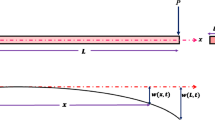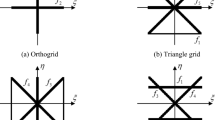Abstract
Clustered tensegrity structures, which retain the advantages of the classical tensegrity structure, are better controllable, and provide more possibilities for a wide range of application scenarios. However, the dynamic modeling and analysis of clustered tensegrity structures with the significant characteristic of rigid-flexible-soft coupling have great challenges: (1) Rigid components (rods) and flexible components (classical cables) lead to a dynamic model that has the characteristic of rigid-flexible coupling, which severely limits the efficiency of dynamic simulation; (2) The "soft" characteristic of sliding cable slacking, which makes sliding cables frequently switch between tense and slack states in the actuation process, results in non-smooth dynamic behavior. In this paper, a model smoothing method based on the positional finite element method is proposed for dynamic analysis of clustered tensegrity structures with the rigid-flexible coupling characteristic, which can effectively and controllably filter the elastic high-frequency oscillations in the system without losing the accuracy of structural macroscopic deformation and greatly improve the computational efficiency than the model without smoothing. Then, for the non-smooth dynamics caused by soft characteristic, a nonlinear complementary method for sliding cable slacking is proposed, which makes the numerical simulation of sliding cable slacking and tensioning more stable than the traditional method. Finally, the model smoothing method for rigid-flexible coupling is integrated with the nonlinear complementary method for soft sliding cables, and a rigid-flexible-soft coupling framework that combines the implicit discrete scheme is formed for dynamic modeling and analysis of clustered tensegrity structures. The numerical simulation results show that the rigid-flexible-soft coupling framework can realize efficient, stable, and accurate dynamic analysis of clustered tensegrity structures and provide support for the design of clustered tensegrity structures.





















Similar content being viewed by others
Data availability
The data generated or analyzed during the current study are available from the corresponding author on reasonable request.
References
Rhode-Barbarigos, L., Ali, N.B.H., Motro, R., Smith, I.F.: Designing tensegrity modules for pedestrian bridges. Eng. Struct. 32(4), 1158–1167 (2010)
Veuve, N., Safaei, S.D., Smith, I.F.: Active control for mid-span connection of a deployable tensegrity footbridge. Eng. Struct. 112, 245–255 (2016)
Li, W., Nabae, H., Endo, G., Suzumori, K.: New soft robot hand configuration with combined biotensegrity and thin artificial muscle. IEEE Robot. Autom. Lett. 5(3), 4345–4351 (2020)
Zhang, M., Geng, X., Bruce, J., Caluwaerts, K., Vespignani, M., SunSpiral, V., Abbeel, P., Levine, S.: Deep reinforcement learning for tensegrity robot locomotion. In: 2017 IEEE international conference on robotics and automation, pp. 634–641. Singapore (2017)
Lee, H., Jang, Y., Choe, J.K., Lee, S., Song, H., Lee, J.P., Lone, N., Kim, J.: 3D-printed programmable tensegrity for soft robotics. Sci. Robot. 5, eaay9024 (2020)
Sultan, C.: Tensegrity: 60 years of art, science, and engineering. Adv. Appl. Mech. 43, 69–145 (2009)
Bauer, J., Kraus, J.A., Crook, C., Rimoli, J.J., Valdevit, L.: Tensegrity metamaterials: toward failure-resistant engineering systems through delocalized deformation. Adv. Mater. 33(10), 2005647 (2021)
Liedl, T., Högberg, B., Tytell, J., Ingber, D.E., Shih, W.M.: Self-assembly of three-dimensional prestressed tensegrity structures from DNA. Nat. Nanotechnol. 5(7), 520–524 (2010)
Lu, B., Vecchioni, S., Ohayon, Y.P., Sha, R., Woloszyn, K., Yang, B., Mao, C., Seema, N.C.: 3D hexagonal arrangement of DNA tensegrity triangles. ACS Nano 15, 16788–16793 (2021)
Ali, N.B.H., Rhode-Barbarigos, L., Smith, I.F.: Analysis of clustered tensegrity structures using a modified dynamic relaxation algorithm. Int. J. Solids Struct. 48(5), 637–647 (2011)
Moored, K.W., Bart-Smith, H.: Investigation of clustered actuation in tensegrity structures. Int. J. Solids Struct. 46(17), 3272–3281 (2009)
Ma, S., Chen, M., Skelton, R.E.: Tensegrity system dynamics based on finite element method. Compos. Struct. 280, 114838 (2022)
Kan, Z., Peng, H., Chen, B., Zhong, W.: Nonlinear dynamic and deployment analysis of clustered tensegrity structures using a positional formulation FEM. Compos. Struct. 187, 241–258 (2018)
Zhang, L., Gao, Q., Liu, Y., Zhang, H.: An efficient finite element formulation for nonlinear analysis of clustered tensegrity. Eng. Comput. 33(1), 252–273 (2016)
Chen, M., Bai, X., Skelton, R.E.: Minimal mass design of clustered tensegrity structures. Comput. Methods Appl. Mech. Eng. 404, 115832 (2023)
Ma, S., Chen, M., Skelton, R.E.: Dynamics and control of clustered tensegrity systems. Eng. Struct. 264, 114391 (2022)
Goyal, R., Skelton, R.E.: Tensegrity system dynamics with rigid bars and massive strings. Multibody Syst. Dyn. 469(3), 203–228 (2019)
Cefalo, M., Mirats-Tur, J.M.: A comprehensive dynamic model for class-1 tensegrity systems based on quaternions. Int. J. Solids Struct. 48(5), 785–802 (2011)
Faroughi, S., Khodaparast, H.H., Friswell, M.I.: Non-linear dynamic analysis of tensegrity structures using a co-rotational method. Int. J. Nonlinear Mech. 69, 55–65 (2015)
Wanner, G., Hairer, E.: Solving Ordinary Differential Equations II. Springer, Berlin (1996)
Chang, S.: A novel series of solution methods for solving nonlinear stiff dynamic problems. Nonlinear Dyn. 107(3), 2539–2562 (2022)
Vermeire, B.C.: Paired explicit Runge-Kutta schemes for stiff systems of equations. J. Comput. Phys. 393, 465–483 (2019)
Chen, Y., Li, Y., Huang, Y., Li, M., Liu, Y.: An efficient algorithm based on Broyden’s and generalized-α method for large scale flexible multi-body systems. Appl. Math. Model. 106, 742–755 (2022)
Kennedy, C.A., Carpenter, M.H.: Diagonally implicit Runge-Kutta methods for stiff ODEs. Appl. Numer. Math. 146, 221–244 (2019)
Deng, L., Zhang, Y.: A consistent corotational formulation for the nonlinear dynamic analysis of sliding beams. J. Sound Vib. 476, 115298 (2020)
Guo, X., Zhang, D., Li, L., Zhang, L.: Application of the two-loop procedure in multibody dynamics with contact and constraint. J. Sound Vib. 427, 15–27 (2018)
Song, N., Zhang, M., Li, F., Kan, Z., Zhao, J., Peng, H.: Dynamic research on winding and capturing of tensegrity flexible manipulator. Mech. Mach. Theory 193, 105554 (2024)
Bathe, K., Noh, G.: Insight into an implicit time integration scheme for structural dynamics. Comput. Struct. 98, 1–6 (2012)
Kim, W., Choi, S.Y.: An improved implicit time integration algorithm: the generalized composite time integration algorithm. Comput. Struct. 196, 341–354 (2018)
Ji, Y., Xing, Y., Wiercigroch, M.: An unconditionally stable time integration method with controllable dissipation for second-order nonlinear dynamics. Nonlinear Dyn. 105(4), 3341–3358 (2021)
Baumgarte, J.: Stabilization of constraints and integrals of motion in dynamical systems. Comput. Methods Appl. Mech. Eng. 1(1), 1–16 (1972)
Zhang, X., Qi, Z., Wang, G., Guo, S.: Model smoothing method of contact-impact dynamics in flexible multibody systems. Mech. Mach. Theory 138, 124–148 (2019)
Zhang, Z., Mao, H., Hou, J., Wang, L., Wang, G.: Development and implementation of model smoothing method in the framework of absolute nodal coordinate formulation. Proc. Inst. Mech. Eng. Part K J. Multi Body Dyn. 235(3), 312–325 (2021)
Zheng, X., Zhu, X., Chen, Z., Wang, X., Liang, B., Liao, Q.: An efficient dynamic modeling and simulation method of a cable-constrained synchronous rotating mechanism for continuum space manipulator. Aerosp. Sci. Technol. 119, 107156 (2021)
Zheng, X., Yang, T., Chen, Z., Wang, X., Liang, B., Liao, Q.: ALE formulation for dynamic modeling and simulation of cable-driven mechanisms considering stick-slip frictions. Mech. Syst. Signal Process. 168, 108633 (2022)
Zhang, L., Gao, Q., Zhang, H.W.: An efficient algorithm for mechanical analysis of bimodular truss and tensegrity structures. Int. J. Mech. Sci. 70, 57–68 (2013)
Kan, Z., Li, F., Song, N., Peng, H.: Novel nonlinear complementarity function approach for mechanical analysis of tensegrity structures. AIAA J. 59(4), 1483–1495 (2021)
Caluwaerts, K., Despraz, J., Işçen, A., et al.: Design and control of compliant tensegrity robots through simulation and hardware validation. J. R. Soc. Interface. 11(98), 20140520 (2014)
Chen, L., Kim, K., Tang, E., Li, K., House, R., Zhu, E.L., Fountain, K., Agogino, A.M., Agogino, A., Sunspiral, V., Jung, E.: Soft spherical tensegrity robot design using rod-centered actuation and control. J. Mech. Robot. 9(2), 025001 (2017)
Zhang, J., Hu, Y., Li, Y., Ma, Y., Wei, Y., Yang, J., Wu, Z., Rajabi, H., Peng, H., Wu, Y.: Versatile Like a Seahorse Tail: a bio-Inspired programmable continuum robot for conformal grasping. Adv. Intell. Syst. 4(11), 2200263 (2022)
Zhang, J., Li, Y., Kan, Z., Yuan, Q., Rajabi, H., Wu, Z., Peng, H., Wu, J.: A preprogrammable continuum robot inspired by elephant trunk for dexterous manipulation. Soft Robot. 10(3), 636–646 (2023)
Banerjee, A.: Flexible Multibody Dynamics: Efficient Formulations with Applications. CRC Press, Boca Raton (2022)
Facchinei, F., Pang, J.: Finite-Dimensional Variational Inequalities and Complementarity Problems. Springer, New York (2003)
Fischer, A.: A special Newton-type optimization method. Optimization 24(3), 269–284 (1992)
Biboulet, N., Lubrecht, A.A.: Efficient solver implementation for Reynolds equation with mass-conserving cavitation. Tribol. Int. 118, 295–300 (2018)
Zhang, X., Qi, Z., Wang, G., Guo, S., Qu, F.: Numerical investigation of the seismic response of a polar crane based on linear complementarity formulation. Eng. Struct. 211, 110462 (2020)
Gao, S., Chen, Y., Huang, S., Xia, Y.: Efficient power flow algorithm for AC/MTDC considering complementary constraints of VSC’s reactive power and AC node voltage. IEEE Trans. Power Syst. 36(3), 2481–2490 (2020)
Liu, Z., Cai, Z., Peng, H., Zhang, X., Wu, Z.: Morphology and tension perception of cable-driven continuum robots. IEEE ASME. Trans. Mech. 28(1), 314–325 (2023)
Newmark, N.M.: A method of computation for structural dynamics. J .Eng. Mech. Div. 85(3), 67–94 (1959)
Hilber, H.M., Hughes, T.J., Taylor, R.L.: Improved numerical dissipation for time integration algorithms in structural dynamics. Earthq. Eng. Struct. D 5(3), 283–292 (1977)
Chung, J., Hulbert, G.M.: A time integration algorithm for structural dynamics with improved numerical dissipation: the generalized-α method. J. Appl. Mech. 60(2), 371–375 (1993)
Peng, H., Song, N., Li, F., Tang, S.: A mechanistic-based data-driven approach for general friction modeling in complex mechanical system. J. Appl. Mech. 89(7), 071005 (2022)
Bottasso, C.L., Dopico, D., Trainelli, L.: On the optimal scaling of index three DAEs in multibody dynamics. Multibody Syst. Dyn. 19, 3–20 (2008)
Peng, H., Yang, H., Li, F., Yang, C., Song, N.: A unified framework for mechanical modeling and control of tensegrity robots. Mech. Mach. Theory 191, 105498 (2024)
Funding
The authors are grateful to the National Natural Science Foundation of China (U2241263); the Fundamental Research Funds for the Central Universities (DUT22ZD211, DUT22QN223).
Author information
Authors and Affiliations
Corresponding author
Ethics declarations
Conflict of interest
The authors declare that they have no known competing financial interests or personal relationships that could have appeared to influence the work reported in this paper.
Additional information
Publisher's Note
Springer Nature remains neutral with regard to jurisdictional claims in published maps and institutional affiliations.
Rights and permissions
Springer Nature or its licensor (e.g. a society or other partner) holds exclusive rights to this article under a publishing agreement with the author(s) or other rightsholder(s); author self-archiving of the accepted manuscript version of this article is solely governed by the terms of such publishing agreement and applicable law.
About this article
Cite this article
Peng, H., Wang, M., Yang, H. et al. Rigid-flexible-soft coupling dynamic modeling and analysis of clustered tensegrity. Nonlinear Dyn (2024). https://doi.org/10.1007/s11071-024-09475-1
Received:
Accepted:
Published:
DOI: https://doi.org/10.1007/s11071-024-09475-1




